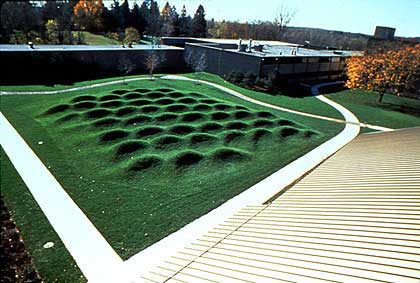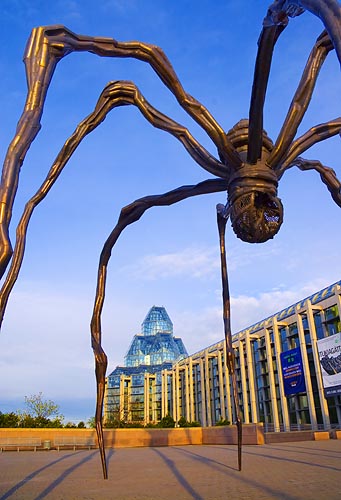Sculptures of Spring '08
Emily Bzdyk
Project 3- Site / Place
ARTIST RESEARCH
Site specific work
Maya Lin is focused on the idea of making a place for individuals within the landscape. Her work is oriented around selecting or being presented with a site, and then developing the work to fit that site. "I work with the landscape, and I hope that the object and the land are equal partners.” She uses the site as a launch-pad, so that specifics of the site determine the nature of her work. She does research about the context of the place or what it means in terms of the project. She draws inspiration for her sculpture and architecture from many different sources, including Japanese gardens, Hopewell Indian earthen mounds, and works by American earthworks artists of the 1960s and 1970s. In terms of formal elements, Maya Lin uses water and fluidity, which appear in many works as rolling hills or rounded geometric shapes.

Perhaps her best-known work is the Vietnam Memorial in Washington DC. This work affects the site in minimal ways, as two lines of polished stone wedges which form an obtuse angle set into the earth, like a giant dent in the face of the park. The level of the depression is six feet, tying in the element of death, and the dark color of the stone. Yet the reflective surface mirrors the onlooker in their personal reflection of their feeling about the site and the events of the war, or loved ones they are remember in their visit. Other memorials of Maya Lin’s have similar elements of interactivity, which allow the viewers to connect with the site in a very reactive way. The pieces are tactile, visual and auditory in many instances. They place the viewer within the site and provide an entrance, or a catalyst for the audience to experience the site in their own way.

“The Wave field” is a good example of how context of the site affects the design. This work is a series of raised rolling earthen mounds, which cover 10,000 square feet on a University of Michigan’s campus near the building for aerospace engineering. She drew the form for this work from the Stokes wave, a naturally occurring pattern appearing in ocean waves. She came to this design by researching fluid mechanics and aerodynamics. The work is an accessible grassy field where children can play and people can physically enter and explore the work firsthand.
Maya Lin’s work is totally reactive and dependent on site. Her works are designed around preserving the integrity of a site, and semi-minimalist additive designs that allow people to better explore the site.
Imagined spaces
Louis Bourgeois has been working for over 7 decades. She is one of the most important contemporary artists today in terms of impact. Her works span a wide variety of subject matter and materials. Bourgeois has worked in marble, wood, paint, bronze, plaster, and latex. In terms of place, her works create an imagined space, drawing from personal memory and her own mental processes. Her works are very personal and include installations such as the ‘cells” which have to do with her agoraphobic thoughts and fragility and pain. The cells represent different types of pain: the physical, the emotional and the psychological, and the mental and intellectual. They tackle the relationships between these different forms of pain, and how they move back and forth, morphing into different manifestations. The cells physically include steel bars and glass panes in a protective, and simultaneously trapping cage room. Within there are glass spheres and other abstract forms, or partial human forms.

In ‘Glass Spheres and Hands’ The glass orbs rest on chairs arranged facing each other. On the table are two marble hands in a cupping gesture. The glass spheres represent fragility of human persons. They are transparent, but enclosed and isolated and inaccessible. The clasped hands are despairing. All these references are extremely personal to Louise Bourgeois herself, and the abstract or representative forms bring specific meaning for her, and provoke speculation in viewers. The fabricated place has a direct connection to Louis bourgeois’s mind.
These setups or rooms are often partially obscured, you have to peek in and this goes back to the fact that this is a personal and elusive space, which is mostly closed off. The viewer have to struggle to see what is going on, and are still left with an incomplete or confused story. The abstraction of the forms that often occurs creates much room for interpretation.

Another series done by Bourgeois is ‘Maman’. These pieces are a reference to her mother. the spider has to do with weaving and sewing, and the umbrella shape of protection which is maternally provided by the spider for her eggs in a steel cage. The abstracted and towering form evokes many different responses from viewers, depending on their own personal context and feelings toward the symbolism involved. These forms come from Bourgeois imagination, which are then transplated to create a space that can be experienced by others. This kind of personal communication is what makes art a very effective way for expression of complex internal ideas.
Sources:
http://en.wikipedia.org/wiki/Maya_Lin
http://www.pbs.org/art21/artists/lin/clip2.html#
www.achievement.org/.../achievers/lin0-029
http://www.oneroom.org/sculptors/bourgeois.html
http://www.24hourmuseum.org.uk/nwh_gfx_en/ART51348.html
http://www.pbs.org/art21/artists/bourgeois/card1.html
http://findarticles.com/p/articles/mi_m0268/is_n10_v31/ai_14156122/pg_2
St. Mary's College of Maryland
St. Mary's City MD 20686-3001
Back to Index
This page was last updated: March 31, 2008 2:44 PM